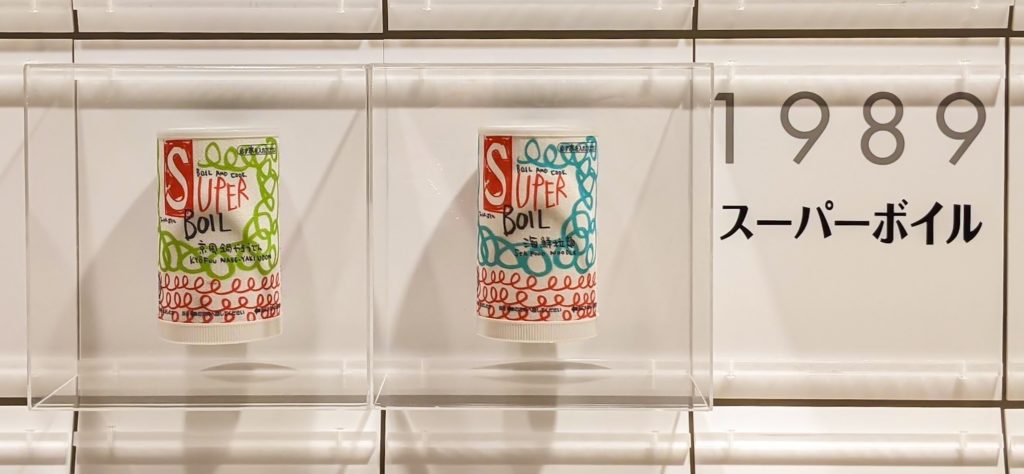Super Boil, Nissin’s (failed) Great Innovation

Momofuku Ando, creator of the world’s first instant ramen, founded the company that would go on to be Nissin in 1948. Originally called Chuko Sosha, it sold salt until its founder’s brainwave in 1958 to flash-fry noodles and sell them with chicken-flavoured seasoning. Not long after that, the company was renamed to Nissin, and noodle-based history was born.
Instant ramen was a revolution when it came to pre-packaged food, and in 1971 Momofuku Ando repeated this feat with the introduction of Cup Noodles, instant ramen packaged in a styrofoam cup, which meant that with just the addition of hot water you could have a meal of instant ramen no matter where you were. This new, improved instant ramen also came with pieces of dehydrated protein (meat or prawns) and vegetables, which gave it at least something of the appearance of a full meal in a cup. Cup Noodles were an immediate, massive success, and with them, Nissin changed the face of pre-packaged food once again.
With two massive successes to their name, Nissin was anxious for a third big win, and in 1989 they thought they’d found it. Super Boil was going to be their next great innovation, and the next big step in instant meals. Nissin was fully committed to their newest idea, commissioning renowned artist Katsuhiko Hibino to design the packaging and placing advertisements in many major magazines of the time. However, their third great leap was not to be.
Super Boil was an innovative idea, that much is definitely true. Packaged in a steel can, the user would open the lid and remove a disposable fork and a small metal key. They would fill the can with water, insert the key into the base of the can and then twist the base several times to start a thermite reaction. This would boil the water to cook the noodles, and they would be ready to eat in about five minutes.
In terms of innovation it was an excellent idea — a hot meal you could take anywhere and prepare with only the addition of water! But in terms of practicality, it left a great deal to be desired. Firstly, there was the price. Selling for ¥500 compared to Cup Noodle’s ¥160, it was a large price hike for what was, once it was cooked, essentially the same product. Secondly, there was the weight. In order to be safely heated to boiling temperatures, the can needed to be made of steel, as well as needing to be insulated to prevent burns. This made Super Boil cans fairly heavy for what was supposed to be a “portable” food, and especially for one that was being heavily marketed to hikers and travelers. And thirdly, there was the issue of safety. In order to cook the noodles, Super Boil had to reliably bring the temperature of the water to over 100°C, a temperature the cans often exceeded. It also needed to be prepared on a flat surface — another limitation for the hiking demographic — and there was a constant and unavoidable risk of bumping it and sending boiling water everywhere.
Ultimately, Super Boil was provided to focus groups and test audiences, and had a very limited release in a few supermarkets, but never fully made it to market. Super Boil is undoubtedly not Nissin’s only product failure in their over sixty year history, but it’s one they have remembered — although it’s tucked unobtrusively high up, it’s the only product included in their Cup Noodles Museum timeline wall that starts and finishes in a single year and doesn’t have a long line of follow up products stretching after it. On the Nissin webpage, where it also has its own dedicated page, Nissin says that their attempt at a third great instant meal revolution taught them a valuable lesson: that no matter how innovative the technology may be, if it’s not married to practicality, it serves no purpose as it won’t be accepted by customers.
—————————-
Support me on Patreon or Ko-Fi!
—————————-
References, because this turned out a lot more like a university essay than I originally anticipated, and also if I spent two hours tracking down information, everybody is going to know about it.
Hikaru Ijuin’s Sunday Secret Base web archive (Japanese): https://web.archive.org/web/20030628002907/http://www.tbs.co.jp/radio/chino/solution/main.html
Nissin History (Japanese): https://www.nissin.com/jp/about/history/columns/1687
Rafu Shimpo “A Revolution In A Cup”: https://rafu.com/2013/02/a-revolution-in-a-cup/
Newspaper SG: https://eresources.nlb.gov.sg/newspapers/Digitised/Article/newpaper19891107-1.2.25.2
Wikipedia Japan Super Boil (Japanese): https://ja.m.wikipedia.org/wiki/スーパーボイル
Thanks for the insight into the tortuous history of noodles. I’ll endeavour to keep my innovations practical.
I can see why the idea didn’t quite take off, but I can’t help but be curious about the product. The way it tasted, the process of heating that way, the feel of it being just heavier than one would expect from a “instant” style food we know today.